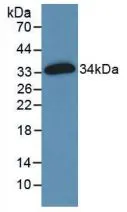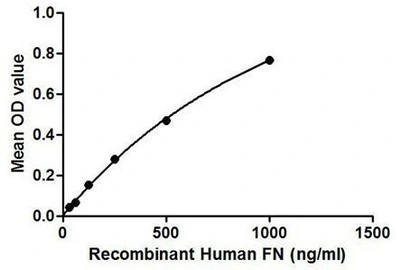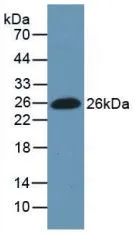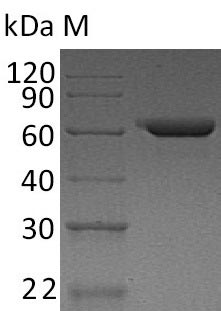
WB analysis of GTX00165-pro Human Fibronectin protein.
Human Fibronectin protein, His tag
GTX00165-PRO
ApplicationsFunctional Assay
Product group Proteins / Signaling Molecules
Protein IDP02751
Overview
- SupplierGeneTex
- Product NameHuman Fibronectin protein, His tag
- Delivery Days Customer9
- Application Supplier NoteFibronectin (FN) is a high-molecular weight (~440kDa) glycoprotein of the extracellular matrix that binds to membrane-spanning receptor proteins called integrins. Fibronectins bind cell surfaces and various compounds including collagen, fibrin, heparin, DNA, and actin. Fibronectin has numerous functions. For example, it involved in cell adhesion, cell motility, opsonization, wound healing, maintenance of cell shape, and so on. Besides, Decorin (DCN) has been identified as an interactor of FN, thus a binding ELISA assay was conducted to detect the interaction of recombinant human FN and recombinant human DCN. Briefly, FN were diluted serially in PBS, with 0.01% BSA (pH 7.4). Duplicate samples of 100 microl were then transferred to DCN-coated microtiter wells and incubated for 2h at 37C. Wells were washed with PBST and incubated for 1h with anti-FN pAb, then aspirated and washed 3 times. After incubation with HRP labelled secondary antibody, wells were aspirated and washed 3 times. With the addition of substrate solution, wells were incubated 15-25 minutes at 37C. Finally, add 50 microl stop solution to the wells and read at 450nm immediately. The binding activity of of FN and DCN was in a dose dependent manner.
- ApplicationsFunctional Assay
- CertificationResearch Use Only
- ConjugateUnconjugated
- Protein IDP02751
- Protein NameFibronectin
- Scientific DescriptionThis gene encodes fibronectin, a glycoprotein present in a soluble dimeric form in plasma, and in a dimeric or multimeric form at the cell surface and in extracellular matrix. The encoded preproprotein is proteolytically processed to generate the mature protein. Fibronectin is involved in cell adhesion and migration processes including embryogenesis, wound healing, blood coagulation, host defense, and metastasis. The gene has three regions subject to alternative splicing, with the potential to produce 20 different transcript variants, at least one of which encodes an isoform that undergoes proteolytic processing. The full-length nature of some variants has not been determined. [provided by RefSeq, Jan 2016]
- Storage Instruction-20°C or -80°C,2°C to 8°C
- UNSPSC12352202







